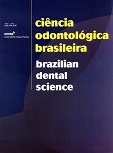Avaliação da deflexão das cuspides de pré-molares restaurados
DOI:
https://doi.org/10.14295/bds.2008.v11i4.656Resumo
O objetivo desse trabalho foi comparar a deflexão das cúspides em pré-molares humanos restaurados com amálgama e posteriormente substituídos por resina composta direta, por meio da aplicação de uma carga oclusal. Para isso 13 pré-molares extraídos por razões ortodônticas, de dimensões similares foram selecionados e embutidos em bases de resina acrílica. Um strain gauge foi colado na superfície lingual da cúspide de cada dente. Os dentes íntegros foram submetidos a uma carga oclusal de 100N. Após a mensuração da deflexão das cúspides dos dentes íntegros (Grupo 1 - Controle), foram realizadas cavidades tipo MOD e restauradas com amálgama (Grupo 2). Após 24 horas, a deflexão das cúspides foi novamente avaliada com os strain gauges. As restaurações de amálgama foram então removidas e os dentes foram restaurados com resina composta direta (Grupo 3) e a deflexão de suas cúspides foi reavaliada após 24 horas. Uma análise exploratória foi realizada para determinar qual o teste estatístico mais apropriado para o estudo. Valores de distribuição (média e intervalo inter-quartil) para os grupos restaurados com amálgama (14.53; 11.16 - 19.18 με), resina composta (6.25; 4.83 - 7.92 με) e para os dentes hígidos (0.44; 0.15 - 4.85 με), foram submetidos ao teste de Kruskal-Wallis (α = 5%) e pelo teste de Dunn (5%). Os dentes hígidos mostraram menor deflexão das cúspides, seguidos dos elementos restaurados com resina composta e uma maior deflexão das cúspides e foi encontrada nos elementos restaurados com amálgama de prata. Pode-se então afirmar, pelos resultados obtidos neste estudo, que a substituição do amálgama pelas resinas compostas em dentes posteriores, com a finalidade de reforço das estruturas remanescentes, se torna indicada
Downloads
Downloads
Publicado
Como Citar
Edição
Seção
Licença
TRANSFERÊNCIA DE DIREITOS AUTORAIS E DECLARAÇÃO DE RESPONSABILIDADE
Toda a propriedade de direitos autorais do artigo "____________________________________________________________________" é transferido do autor(es) para a CIÊNCIA ODONTOLÓGICA BRASILEIRA, no caso do trabalho ser publicado. O artigo não foi publicado em outro lugar e não foi submetido simultaneamente para publicação em outra revista.
Vimos por meio deste, atestar que trabalho é original e não apresenta dados manipulados, fraude ou plágio. Fizemos contribuição científica significativa para o estudo e estamos cientes dos dados apresentados e de acordo com a versão final do artigo. Assumimos total responsabilidade pelos aspectos éticos do estudo.
Este texto deve ser impresso e assinado por todos os autores. A versão digitalizada deverá ser apresentada como arquivo suplementar durante o processo de submissão.




























